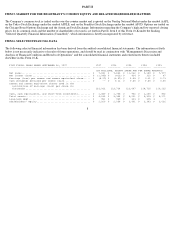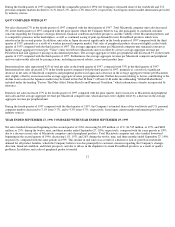Apple 1997 Annual Report Download - page 21
Download and view the complete annual report
Please find page 21 of the 1997 Apple annual report below. You can navigate through the pages in the report by either clicking on the pages listed below, or by using the keyword search tool below to find specific information within the annual report.opened its on-line store, which makes available most of its products to end-users in the U.S., in November 1997. There can be no assurance the
on-line store will result in greater sales. The Company also began manufacturing products on a build-to-order basis in November 1997. There
can be no assurance this manufacturing process will result in decreased costs or increased gross margins. The Company is also reducing the
number of wholesale and retail channel partners, particularly in the Americas, which places a greater volume of sales through fewer partners.
There can be no assurance that this will not adversely impact the Company. In addition, the actions taken in connection with the restructuring
could adversely affect employee morale, thereby damaging the Company's ability to retain and motivate employees. Also, because the
Company contemplates relying to a greater extent on collaboration and licensing arrangements with third parties, the Company will have less
direct control over certain of its research and development efforts, and its ability to create innovative new products may be reduced. In addition,
there can be no assurance that the technologies acquired from NeXT will be successfully exploited, or that key NeXT employees and processes
will be retained and successfully integrated with those at Apple. Also, the restructuring includes the winding down of the Company's Mac OS
licensing program. There can be no assurance that the winding down of this program will result in greater sales, market share, and increased
gross margins to the Company. In addition, there can be no assurance that this action will not result in the availability of fewer application
software titles for the Mac OS, which may result in a decrease to the Company's sales, market share and gross margins. Finally, even if the
restructuring is successfully implemented, there can be no assurance that it will effectively resolve the various issues currently facing the
Company. Although the Company believes that the actions it is taking in connection with the restructuring, including its acquisition of NeXT
and the winding down of its Mac OS licensing program, should help restore marketplace confidence in the Company, there can be no assurance
that such actions will enable the Company to achieve its objectives of reducing its cost structure, improving its competitiveness, and restoring
sustainable profitability. The Company's future consolidated operating results and financial condition could be adversely affected should it
encounter difficulty in effectively managing the restructuring and new cost structure.
Additional information relating to the restructuring of operations may be found in Part II, Item 8 of this Form 10-K in the Notes to
Consolidated Financial Statements under the subheading "Restructuring of Operations" included under the heading "Special Charges," which
information is hereby incorporated by reference.
PRODUCT INTRODUCTIONS AND TRANSITIONS
Due to the highly volatile nature of the personal computer industry, which is characterized by dynamic customer demand patterns and rapid
technological advances, the Company must continuously introduce new products and technologies and enhance existing products in order to
remain competitive. Recent introductions include certain PowerBook and Power Macintosh products, and the introduction of Mac OS 8 in July
1997. The success of new product introductions is dependent on a number of factors, including market acceptance, the Company's ability to
manage the risks associated with product transitions, the availability of application software for new products, the effective management of
inventory levels in line with anticipated product demand, the availability of products in appropriate quantities to meet anticipated demand, and
the risk that new products may have quality or other defects in the early stages of introduction. Accordingly, the Company cannot determine the
ultimate effect that new products will have on its sales or results of operations. In addition, although the number of new product introductions
may decrease as a result of the Company's restructuring actions, the risks and uncertainties associated with new product introductions may
increase as the Company refocuses its product offerings on key growth segments and to the extent new product introductions are in markets
that are new to the Company.
The rate of product shipments immediately following introduction of a new product is not necessarily an indication of the future rate of
shipments for that product, which depends on many factors, some of which are not under the control of the Company. These factors may
include initial large purchases by a
18
























